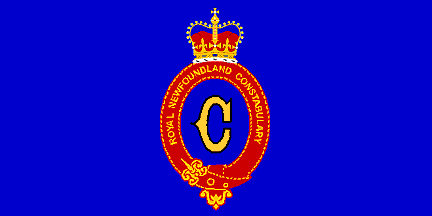 image by Željko Heimer
image by Željko Heimer 
Last modified: 2006-07-01 by phil nelson
Keywords: newfoundland and labrador | canada | union jack (stylized) | royal newfoundland constabulary |
Links: FOTW homepage |
search |
disclaimer and copyright |
write us |
mirrors
See also:
Outside Links:
Alistair Fraser notes:
Using the elements the committee had found to be uppermost in the minds of the public, Newfoundland artist, Christopher Pratt, drafted many proposals, six of which he submitted to the committee. Pratt's favourite was the one the committee, and ultimately the House of Assembly chose. It was given royal assent on June 6, 1980 and raised for the first time on June 24, Discovery Day, the anniversary of the arrival in Newfoundland of John Cabot in 1497.Smith (Flag Bulletin XX, 2) gives same date for first hoisting. The selection by the committee of the House of Assembly was 29 April 1980. The vote in Assembly was 26 May (22 votes for, 10 against, 20 abstentions). Royal assent is dated 28 May 1980, and bill signed by Lt. Governor 6 June 1980
Znamierowski is perfectly right in that the flag was adopted by 'An Act to Adopt a Flag for the Province' which received Royal Assent on 28 May 1980 (I have a copy on file). It was first officially raised on 23 June 1980.
Christopher Southworth, 29 April 2003From the Newfoundland and Labrador tourism site, http://www.gov.nf.ca/tourism/topmenu/info/default.htm:
In this flag, the primary colours of red, gold and blue are placed against a background of white to allow the design to stand clearly. White is representative of snow and ice; blue represents the sea; red represents human efforts; and gold our confidence in ourselves. The blue section, most reminiscent of the Union Jack, represents our Commonwealth heritage which has so decisively shaped our present. The red and gold section, larger than the other, represents our future. The two triangles outlined in red portray the mainland and island parts of our province reaching forward together. A golden arrow points the way to what we believe will be a bright future. Surrounded by red to indicate human effort, the arrow suggests that our future is for making and not the taking. But the design of the flag encompasses much more symbolism than this. For example, the Christian Cross, the Beothuk and Naskapi ornamentation, the outline of the maple leaf in the centre of the flag, a triumphant figure and our place in the space age. The image of a trident stands out. This is to emphasize our continued dependence on the fishery and the resources of the sea. Hung as a banner, the arrow assumes the aspect of a sword which is to remind us of the sacrifice of our War Veterans. Since the whole flag resembles a Beothuk pendant, as well as all the above, the design takes us from our earliest beginnings and points us confidently forward. It, therefore, mirrors our past, present and future. The flag was officially adopted on June 6, 1980. The flag was designed by artist Christopher Pratt.
Before 1949 Newfoundland had a Governor-General rather than a Lt. Gov., as it was self-governing and not a Canadian province. His flag had a green *laurel* leaf garland, and the 'terra nova' badge surmounted by a royal crown.
It is recorded as changing, in 1904, from 'the badge applied to the disc',
to, 'the badge filling the whole disc'. To me, this implies that the crown
now protruded above the top of the disc, breaking the garland, just as on
the Canadian Governor-General's flag.
David Prothero, 19 February 1997
The shield of the arms of Newfoundland used on the flag of the lieutenant-governor
adopted in January 1987. As a colony, Newfoundland was granted for a defaced
red ensign (Admiralty Warrant of 25 October 1918). On The
Observer's book of Flags" Ed. 1979, W. Crampton wrote that "The official
flag of Newfoundland and Labrador is the Union Jack, although vessels in the
service of the province may use the Blue Ensign with a badge in the fly".
Mario Fabretto, 2 October 1997
 image by Herbert FMY and Martin Grieve 24 May 2006
image by Herbert FMY and Martin Grieve 24 May 2006
The flag has a blue field throughout on which the badge of the Royal Newfoundland Constabulary is charged. The badge comprises of a red garter with gold/yellow seams, buckles and loops. The text 'Royal Newfoundland Constabulary' is inscribed on the garter in gold/yellow. Within the garter is the letter 'C' in gold and the St. Edward's crown surmounts the entire badge.
The photo gallery at the constabulary's website also suggests the existence of an indoor version of the flag completed with gold fringes (uncertain of the existence of cords and tassels though).
A larger image of the Royal Newfoundland Constabulary
badge can be seen at justice.gov.nl.ca.
Herman FMY, 24 May 2006